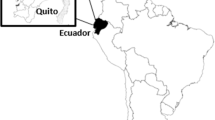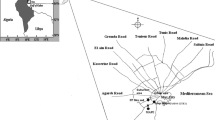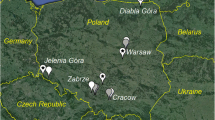Abstract
O3, NO2, SO2, CO and PM10 concentrations, simultaneously determined for the first time in Belgrade urban area in the autumnal period of 2005, are presented. The obtained results display similar behaviour of SO2, NO2, CO, PM10 opposite from that of O3. The weekend effect was also investigated showing diminution of average daily concentrations of SO2, NO2, PM10 and CO for 72, 40, 37 and 42% respectively, and increase of the average daily concentration of O3 for 56%. Influence of meteorological conditions on observed concentration levels was studied, too. The observed influence of wind speed on the O3 nightly concentration levels was analyzed pointing to the phenomena of O3 transport during episodic measurements. To make an identification of possible pollution sources and analyse the influence of meteorological parameters on pollution levels, air back trajectories for high level concentrations episodes were calculated and analysed. A multivariate receptor modelling (Principal Component Analysis, Cluster Analysis) has been applied to a set of data in order to determine the contribution of different sources. It was found that the main principal components, extracted from the air pollution data, were related to gasoline combustion, oil combustion and ozone transport.
Similar content being viewed by others
References
Altshuler, S. L., Arcado, T. D., & Lawson, D. R. (1995). Weekday vs weekend ambient ozone concentrations: Discussions and hypotheses with focus on northern California. Journal of the Air and Waste Management Association, 45, 967–972.
Aneja, P. V., Kim, D. S., & Chameides, W. L. (1996). Trends and analysis of ambient NO, NOy, CO, and ozone concentrations in Raleigh, North Carolina. Chemosphere, 34, 611–623.
Barrero, M. A., Grimalt, J. O., & Canton, L. (2006). Prediction of daily ozone concentrations and maxima in urban atmosphere. Chemometrics and Intelligent Laboratory Systems, 80, 67–76.
Caciola, R. R., Sarva, M., & Pasola, R. (2002). Adverse respiratory effects and allergic susceptibility in relation to particulate air pollution: Flirting with disasters. Allergy, 6, 57–281.
Council Directive 96/62/EC (1996) On ambient air quality assessment and management. Official Journal of the European Communities No.L 296/55, 21.11.1996.
Council Directive 1999/3/EC (1999) Relating to limit values for sulphur dioxide, nitrogen dioxide and oxides of nitrogen, particulate matter and lead in ambient air. Official Journal of the European Communities L, 163, 41–60.
Council Directive 2002/3EC (2002) Relating to ozone in ambient air. Official Journal of the European Communities L, 67, 14–30.
Dreher, D. B., & Harley, R. A. (1988). A fuel-based inventory for heavy-duty diesel truck emissions. Journal of the Air and Waste Management Association, 48, 352–358.
Finlayson-Pitts, B. J., & Pitts, J. N. (1999). Chemistry of the upper and lower atmosphere. New York: Academic Press.
Fleming, J., Stern, R., & Yamartino, R. J. (2005). A new air quality regime classification scheme for O3, NO2, SO2 and PM10 observations sites. Atmospheric Environment, 39, 6121–6129.
Han, X., & Naeher, P. L. (2006). A review of traffic-related air pollution exposure assessment studies in the developing world. Environment International, 32, 106–120.
Janjic, Z. I. (1990). Physical package for the step-mountain, eta coordinate model. Monthly Weather Review, 118, 1429–1443.
Janjic, Z. I. (1994). The step-mountain eta coordinate model: Further developments of the convection, viscous sublayers and turbulence closure schemes. Monthly Weather Review, 122, 927–945.
Kaiser, H. F. (1960). The application of electronic computers to factor analysis. Educational and Psychological Measurement, 20, 141–151.
Marcazzan, G., Vaccaro, S., Valli, G., & Vecchi, R. (2001). Characterization of PM10 and PM2.5 particulate matter in the ambient air of Milan (Italy). Atmospheric Environment, 35, 4639–4650.
Markovic, D. M., & Markovic, A. M. (2005). The relationship between some meteorological parameters and the tropospheric concentrations of ozone in the urban area of Belgrade. Journal of the Serbian Chemical Society, 70, 1478–1495.
Marr, L. C., & Harley, R. A. (2002a). Spectral analysis of weekday-weekend differences in ambient ozone, nitrogen oxide, and non-methane hydrocarbon time series in California. Atmospheric Environment, 36, 2327–2335.
Marr, L. C., & Harley, R. A. (2002b). Modeling the effects of weekday-weekend differences in motor vehicle emissions on photochemical air pollution in Central California. Environmental Sciences and Technology, 36, 4099–4106.
Mesinger, F. (1984). A blocking technique for the representation of mountains in atmospheric model. Rivista di Meteorologia Aeronautica, 44, 195–202.
Mesinger, F., Janjic, Z. I., Nickovic, S., Gavrilov, D., & Deaven, D. G. (1988). The step-mountain coordinate: Model description and performance for cases of Alpine lee cyclogenesis and for a case of an Appalachian redevelopment. Monthly Weather Review, 116, 1493–1518.
Minoura, H. (1999). Some characteristics of surface ozone concentrations observed in an urban atmosphere. Atmospheric Research, 51, 153–169.
National Research Council, US (1991). Rethinking the ozone problem in urban and regional air pollution. Washington, DC: National Academy Press.
Nowak, B. (1998). Contents and relationship of elements in human hair for a non-industrialised population in Poland. Science of Total Environment, 209, 59–68.
Pandey, J. S., Kumar, R., & Devotta, S. (2005). Health risks of NO2, SPM and SO2 in Delhi (India). Atmospheric Environment, 39, 6868–6874.
Qin, Y., Tonnesen, G. S., & Wang, Z. (2004). One-hour and eight-hour average ozone in the California South Coast air quality management district: Trends in peak values and sensitivity to precursors. Atmospheric Environmet, 38, 2197–2207.
Tasić, M., Đurić-Stanojević, B., Rajšić, S., Mijić, Z., & Novaković, V. (2006). Physico-chemical characterization of PM10 and PM2.5 particles in the Belgrade urban area. Acta Chimica Slovenica, 53, 401–405.
Vukovich, F. M., & Sherewell, J. (2003). An examination of the relationship between certain meteorological parameters and surface ozone variations in the Baltimore-Washington corridor. Atmospheric Environment, 37, 971–981.
Author information
Authors and Affiliations
Corresponding author
Rights and permissions
About this article
Cite this article
Marković, D.M., Marković, D.A., Jovanović, A. et al. Determination of O3, NO2, SO2, CO and PM10 measured in Belgrade urban area. Environ Monit Assess 145, 349–359 (2008). https://doi.org/10.1007/s10661-007-0044-1
Received:
Accepted:
Published:
Issue Date:
DOI: https://doi.org/10.1007/s10661-007-0044-1




